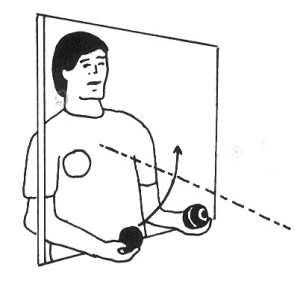|
Copyright 1990 by Martin Frost & Michael Stillsell Mill's
Mess In
this Juggler's Workshop we'll be looking at some interesting
three-ball patterns. One of these is Mill's Mess, a popular pattern
well known for being difficult to learn. This
pattern was popularized by Steve Mills, juggler extraordinaire, and
carries his name. Once you know Mill's Mess you can apply it to many
other tricks to come up with new variations (Mill's Mess clawing,
Mill's Mess behind the back, etc.).
If
you'd like to learn this Hints
on the Cascade *
Keep the balls in a plane about a foot in front of you. Figure 1
shows the imaginary plane in which the balls should stay. If
you find yourself always walking when you juggle, you're throwing too
far forward. Try juggling while facing a wall.
*
Scoop the balls. Imagine a spear sticking out of the center of
your chest (Fig. 1). As you catch each ball, throw it under the spear
with a scooping motion of the wrist. This wrist motion is essential
for a
*
Catch the balls at waist level. Don't reach up to catch the balls.
Let them fall to about waist height before you catch them. This allows
you to keep the pattern comfortably in front of your chest.
*
Stretch your pattern. Practice making your juggling very high and
slow. Then try juggling as low and fast as you can, using lots of
wrist motion. Now juggle as wide as you can. Your goal is to have
control over your pattern. Many jugglers settle on a pattern with the
hands about a foot apart and with the balls going about as high as the
*
Look past your pattern. Practice juggling while walking, reading,
watching T.V. You shouldn't have to look at the balls. Try juggling
while watching yourself in a mirror. Reverse
Cascade Remember
that spear in your chest? Start throwing the balls over the
spear with a scooping is
thrown over the ball being caught instead of under it. Try making one
ball go over while the other two continue under. This is sometimes
called juggler's tennis. Under
the Wrist As
each ball enters your left hand, carry it across your body and under
your right wrist and throw it straight up for your right hand to
catch. Then move the left hand back to the left for its next catch.
Start by doing this every now and then and work up to doing it with
every left hand throw. Then try it with your right hand. The
False Shower This
pattern looks like a shower because the balls follow each other around
in a circle. If you learn this pattern in both directions, you'll be
very close to Mill's Mess.
Begin
by throwing every ball from the left hand under your right wrist, as
you learned above. Now, instead of throwing each underthe-wrist ball
straight up, throw it back to the left. This will force your right
hand to go over to the left side to make the catch. But first, move
your right hand over to the right to throw its ball over the
ball from the left hand.
Both
hands thus throw from the right side and catch on the left. with the
balls all traveling in a counter-clockwise circle. Try to get the same
arc with both hands' throws, to make a smooth even |
